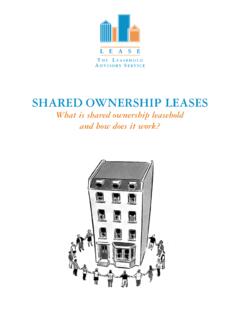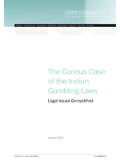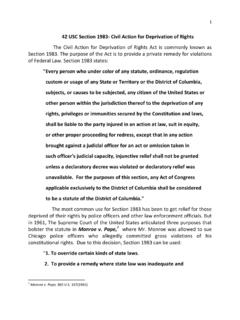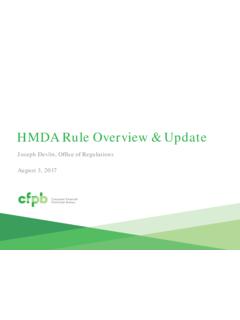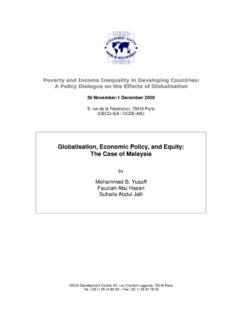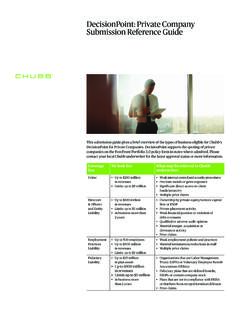Transcription of H R FINANCIAL REPORT - Technology Entrepreneurship
1 HOW TOREAD AFINANCIALREPORTHOW TOREAD AFINANCIALREPORT1 GOALS OF THIS BOOKLETAn annual REPORT is unfamiliar terrain to many people. For those who are notaccountants, analysts or FINANCIAL planners,this booklet can help them to better under-stand such reports and possibly becomemore informed investors. This booklet was written and designed to help educate and guide its readers so they might: Better understand the data included infinancial reports and how to analyze it. Learn more about companies that offeremployment or provide good starting point for achieving thesegoals is to become familiar with the maincomponents of a company s annual Note:Highlighted throughout thisbooklet are key selected terms and defini-tions as a reference for readers.
2 See alsothe Glossary of Selected Terms in the back of this OF AN ANNUAL REPORTMost annual reports have three sections: (1)The Letter to Shareholders, (2) the BusinessReview and (3) the FINANCIAL Review. Eachsection serves a unique function: The Letter to Shareholdersgives a broad overview of the company s business and FINANCIAL performance. The Business Reviewsummarizes a company s recent developments,trends and objectives. The FINANCIAL Reviewpresents a company s business performance in dollar terms and consists of the Management s Discussion andAnalysis and Audited FinancialStatements. It may also contain supplemental FINANCIAL Management s Discussion and Analysis(MD&A),a company s managementexplains significant changes from year to yearin the FINANCIAL statements.
3 Although present-ed mainly in narrative format, the MD&Amay also include charts and graphs highlight-ing the year-to-year changes. The company soperating results, FINANCIAL position, changesin shareholders equity and cash flows arenumerically captured and presented in theaudited FINANCIAL FINANCIAL statements generally consist ofthe balance sheet, income statement, state-ment of changes in shareholders equity,statement of cash flows and footnotes. Theannual FINANCIAL statements usually areaccompanied by an independent auditor sreport (which is why they are called audited FINANCIAL statements). An auditis a systematicexamination of a company s FINANCIAL statements; it is typically undertaken by aCertified Public Accountant(CPA).
4 The audi-tor s REPORT attests to whether the financialreports are presented fairly in keeping withgenerally accepted accounting principles,known as GAAP for short. Following is a brief description or overviewof the basic FINANCIAL statements, includingthe footnotes:The Balance SheetThe balance sheet, also called statement offinancial position, portrays the financialposition of the company by showing whatthe company owns and what it owes at thereport date. The balance sheet may bethought of as a snapshot, since it reportsthe company s FINANCIAL position at a spe-cific point in time. Usually balance sheetsrepresent the current period and a previous2period so that FINANCIAL statement readerscan easily identify significant Income StatementOn the other hand, the income statementcan be thought of more like a motion pic-ture, since it reports on how a companyperformed during the period(s) presentedand shows whether that company s opera-tions have resulted in a profit or Statement of Changes in Shareholders EquityThe statement of changes in shareholders equityreconciles the activity in the equitysection of the balance sheet from period toperiod.
5 Generally, changes in shareholders equity result from company profits orlosses, dividends and/or stock issuances.(Dividendsare payments to shareholdersto compensate them for their investment.)The Statement of Cash FlowsThe statement of cash flowsreports on the company s cash movements during the period(s) separating them by operating,investing and financing FootnotesThe footnotesprovide more detailed infor-mation about the FINANCIAL booklet will focus on the basic FINANCIAL statements, described above, and the related footnotes. It will alsoinclude some examples of methods thatinvestors can use to analyze the basicfinancial statements in greater , to illustrate how these con-cepts apply to a hypothetical, but realistic business, this booklet will present andanalyze the FINANCIAL statements of amodel MODEL COMPANY CALLED TYPICAL To provide a framework for illustration, a fictional company will be used.
6 It will be a public company (generally, onewhose shares are formally registered withthe Securities and Exchange Commission[SEC]and actively traded). A public com-pany will be used because it is required to provide the most extensive amount of information in its annual reports. Therequirements and standards for financialreporting are set by both governmentaland nongovernmental bodies. (The SEC is the major governmental body withresponsibility in this arena. The main nongovernmental bodies that set rules and standards are the FinancialAccounting Standards Board [FASB]*, the American Institute of Certified PublicAccountants [AICPA] and the exchangesthe securities trade fictional company will represent a typical corporation with the most com-monly used accounting and reportingpractices.)
7 Thus, the model company willbe called Typical Manufacturing Company,Inc. (or Typical, for short).* The FASB is the primary, authoritative private-sector body that sets FINANCIAL accounting time to time, these standards change andnew ones are issued. At this writing, the FASB is considering substantial changes to the currentaccounting rules in the areas of consolidations,segment reporting, derivatives and hedging, andliabilities and equity. Information regarding current,revised or new rules can be obtained by writing orcalling the FINANCIAL Accounting Standards Board,401 Merritt 7, Box 5116, Norwalk, CT06858-5116, telephone (203) 847-0700. HOW TOREAD AFINANCIALREPORT3 The following pages show a sample of the core or basic FINANCIAL statements a balance sheet, an income statement, a statement of changes in shareholders equity and a statement of cash flows forTypical Manufacturing , before beginning to examinethese FINANCIAL statements in depth, thefollowing points should be kept in mind: Typical s FINANCIAL statements are illus-trative and generally representative for a manufacturing company.
8 However, FINANCIAL statements in certain special-ized industries, such as banks, broker-dealers, insurance companies and pub-lic utilities, would look somewhat dif-ferent. That s because specializedaccounting and reporting principles and practices apply in these and otherspecialized industries. Rather than presenting a complete setof footnotes specific to Typical, thisbooklet presents a listing of appropriategeneric footnote data for which a readerof FINANCIAL statements should look. This booklet is designed as a broad,general overview of FINANCIAL reporting,notan authoritative, technical referencedocument. Accordingly, specific techni-cal accounting and FINANCIAL reportingquestions regarding a person s personalor professional activities should bereferred to their CPA, accountant orqualified attorney.
9 To simplify matters, the statementsshown in this booklet do notillustrateevery SEC FINANCIAL reporting rule andregulation. For example, the sample statements pre-sent Typical s balance sheet at two year-ends; income statements for two years;and a statement of changes in sharehold-ers equity and statement of cash flows fora one-year period. To strictly comply withSEC requirements, the REPORT would haveincluded income statements, statements of changes in shareholders equity andstatements of cash flows for three , the statements shown here do notinclude certain additional informationrequired by the SEC. For instance, it doesnot include: (1) selected quarterly finan-cial information (including recent marketprices of the company s common stock),and (2) a listing of company directors andexecutive , the MD&A will not be presentednor will examples of the Letter toShareholders and the Business Review be provided because these are not core elements of an annual REPORT .
10 Rather, they are generally intended to be explana-tory, illustrative or supplemental in elaborate on these supplemental com-ponents could detract from this booklet sprimary focus and goal: Providing readerswith a better understanding of the core or basic FINANCIAL statements in an annual FEWWORDSBEFOREBEGINNINGCONSOLIDATED BALANCE SHEETS(Dollars in Thousands, Except Per-Share Amounts)December 31 19X919X8 AssetsCurrent Assets:Cash and cash equivalents$19,500$15,000 Marketable securities46,300 32,000 Accounts receivable net of allowance for doubtful accounts of $2,375 in 19X9 and $3,000 in 19X8156,000145,000 Inventories, at the lower of cost or market180,000185,000 Prepaid expenses and other current assets4,0003,000 Total Current Assets405,800 380,000 Property, Plant and Equipment:Land30,000 30,000 Buildings125,000118,500 Machinery200,000171,100 Leasehold improvements15,00015,000 Furniture, fixtures, ,00012,000 Total property, plant and equipment385,000346,600 Less.
